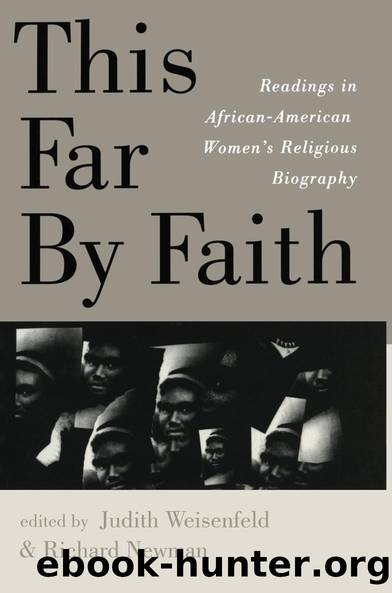This Far By Faith by Judith Weisenfeld Richard Newman

Author:Judith Weisenfeld, Richard Newman [Judith Weisenfeld, Richard Newman]
Language: eng
Format: epub
ISBN: 9780415913126
Barnesnoble:
Publisher: Taylor & Francis
Published: 1995-12-04T00:00:00+00:00
NOTES
1. For histories of blacks in the Reorganization see William D. Russell, âA Priestly Role for a Prophetic Church: The RLDS Church and Black Americans,â Dialogue: A Journal of Mormon Thought 12 (Summer 1979): 37â49; Arlyn R. Love, âThe First Presidencyâs Response to the Civil Rights Movement,â John Whitmer Historical Association Journal 4 (1984): 41â50; and Roger D. Launius, Invisible Saints: A History of Black Americans in the Reorganized Church (Independence: Herald Publishing House, 1988).
2. See Book of Mormon (Independence: Herald Publishing House, 1966 ed.), II Nephi 11:113â15; Book of Doctrine and Covenants (Independence: Herald Publishing House, 1970 ed.), Section 1:1b.
3. The General Conference adopted race-related resolutions in 1875, 1948, 1950, 1956, and two in 1968; see Rules and Resolutions (Independence: Herald Publishing House, 1980 ed.). Each of these resolutions espoused the ideal of Christâs salvation through repentance, regardless of race or condition.
4. No demographic studies of Church population have been done for the nineteenth century, but see discussions of Church growth and development in Roger D. Launius, Joseph Smith III: Pragmatic Prophet (Urbana: University of Illinois Press, 1988), chap. 13; Roger D. Launius, âQuest for Zion: Joseph Smith III and Community-Building in the Reorganization, 1860â1900,â in Restoration Studies III, edited by Maurice L. Draper and Debra Combs (Independence: Herald Publishing House, 1986), 314â32; and Norma Derry Hiles, âLamoni: Crucible for Pluralism in the Reorganization Church,â ibid., 139â44. For the perceptions that white nineteenth-century Americans held of blacks, see William Stanton, The Leopardâs Spots: Scientific Attitudes Toward Race in America, 1815â1859 (Chicago: University of Chicago Press, 1960), and George M. Frederickson, The Black Image in the White Mind (New York: Harper and Row, 1971).
5. Darlene Clark Hine, âRape and the Inner Lives of Black Women in the Middle West: Preliminary Thoughts on the Culture of Dissemblance,â in Unequal Sisters: A Multi-Cultural Reader in U.S. Womenâs History, edited by Ellen Carol DuBois and Vicki L. Ruiz (New York: Routledge, 1990), 292â97. For an essay that approaches gender discrimination in the RLDS Church, see Patricia Struble, âMite to Bishop: RLDS Womenâs Financial Relationship to the church,â John Whitmer Historical Association Journal 6 (1986): 23â32.
6. Amy E. Robbins, âJust Amy: Autobiography,â n.d., mimeographed booklet in my possession. On sexual abuse and its effect on women, see Hine, âRape and the Inner Lives of Black Womenâ; Rennie Simpson, âThe Afro-American Female: The Historical Construction of Sexual Identity,â in The Power of Desire: The Politics of Sexuality, edited by Ann Snitow, Sharon Thompson, and Christine Stansell (New York: Monthly Review Press, 1983), 229â35; Darlene Clark Hine, âLifting the Veil, Shattering the Silence: Black Womenâs History in Slavery and Freedom,â in The State of Afro-American History: Past, Present, and Future, edited by Darlene Clark Hine (Baton Rouge: Louisiana State University Press, 1986), 223â49.
7. Robbins, âJust Amy,â 21â22, 24.
8. Ibid., 22.
9. Ibid., 23.
10. Ibid., 24.
11. Ibid., 24â34; Amy E. Robbins to Wilford G. Winholtz, 17 February 1949, copy in my possession.
12. Amy E. Robbins, âMy Experience as a Negro in the Battle Creek Branch of the Reorganized Church of Jesus Christ of Latter Day Saints,â p.
Download
This site does not store any files on its server. We only index and link to content provided by other sites. Please contact the content providers to delete copyright contents if any and email us, we'll remove relevant links or contents immediately.
Cecilia; Or, Memoirs of an Heiress — Volume 1 by Fanny Burney(32092)
Cecilia; Or, Memoirs of an Heiress — Volume 3 by Fanny Burney(31481)
Cecilia; Or, Memoirs of an Heiress — Volume 2 by Fanny Burney(31435)
The Great Music City by Andrea Baker(30931)
We're Going to Need More Wine by Gabrielle Union(18664)
All the Missing Girls by Megan Miranda(14855)
Pimp by Iceberg Slim(13828)
Bombshells: Glamour Girls of a Lifetime by Sullivan Steve(13718)
Fifty Shades Freed by E L James(12936)
Talking to Strangers by Malcolm Gladwell(12916)
Norse Mythology by Gaiman Neil(12879)
For the Love of Europe by Rick Steves(11666)
Crazy Rich Asians by Kevin Kwan(8912)
Mindhunter: Inside the FBI's Elite Serial Crime Unit by John E. Douglas & Mark Olshaker(8751)
The Lost Art of Listening by Michael P. Nichols(7190)
Enlightenment Now: The Case for Reason, Science, Humanism, and Progress by Steven Pinker(6891)
The Four Agreements by Don Miguel Ruiz(6343)
Bad Blood by John Carreyrou(6295)
Weapons of Math Destruction by Cathy O'Neil(5872)
